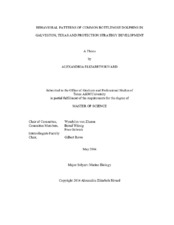| dc.description.abstract | The objective of this study is to establish a protection strategy for common bottlenose dolphins in the Galveston, Texas area based on quantifiable behavioral patterns. This area is subjected to regular vessel traffic entering the commercial ship channels. I used The Galveston-Port Bolivar ferry at the entrance of the ship channels as a platform for assessing variations in dolphin group behavior. Over six months, I conducted 1,412 hours of observation. Resting behavior occurred significantly more frequently than expected in Bolivar; traveling, more frequently in the passage; and foraging more frequently in Galveston (p < 0.01). Traveling dominated in open water (p < 0.01). Foraging was most prevalent in the morning and resting in the evening (p < 0.01). Group size deviated significantly across the assessed factors in a negative binomial hurdle model (p < 0.01). Calves were equally common in all three zones (p > 0.01), but more common in foraging groups and less common in resting groups (p < 0.01). Groups with calves were most frequently found at intermediate distances to shore (p < 0.01), and in the morning time (p < 0.01). Vessel activity was highest in Galveston and lowest in Bolivar, and decreased from the morning to afternoon to evening (p < 0.01)
Next, existing regulation, management, and educational outreach strategies were evaluated to determine their effectiveness, appropriateness, and applicability to marine mammals in Galveston Bay. In many cases, these strategies were insufficient to meet the unique needs of the Galveston area. Federal law enforcement officials are often overtaxed and unable to enforce existing laws; I advise that the State of Texas pass a state law for marine mammal protection and issue a voluntary dolphin rest zone in Bolivar. Existing management strategies are better suited to large corporations, but participation may be beyond the means of smaller companies. I propose a local “Responsible Marine Business” program be instituted in Galveston to promote conservation on a local scale. Public education is critical to any conservation effort; I recommend a multi-pronged outreach, including public workshops, school programs, and educational signage installation to promote bottlenose dolphin protection and encourage ecotourism. | en |


